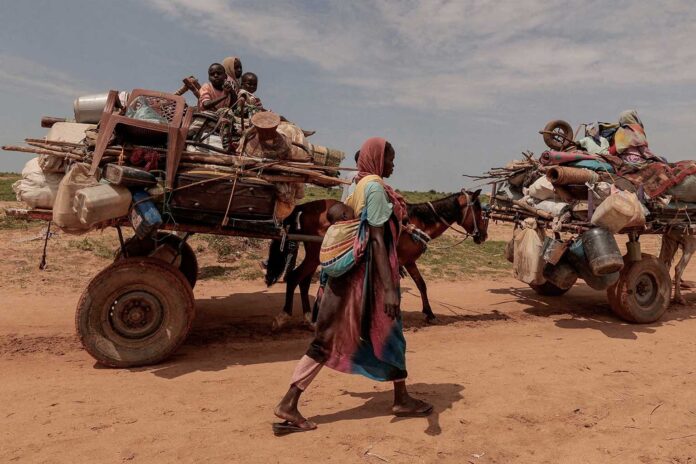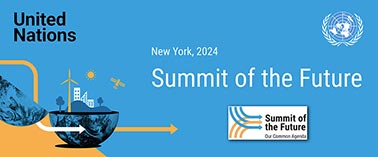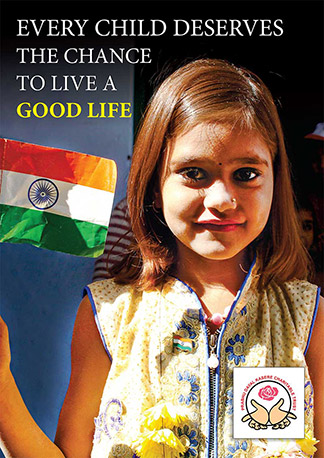Sudan is experiencing a humanitarian crisis of untold proportions. By all humanitarian indicators – the scale of escalating needs, the numbers of people displaced and those facing potential famine – Sudan is one of the worst global humanitarian crises accounting for 13 per cent of the world’s internally displaced persons – that is 1 in every 8 internally displaced person worldwide is in Sudan.
One year since the conflict erupted, more than 8.7 million people have fled their homes, including 4.6 million children, with 6.8 million displaced inside Sudan and 1.8 million people fleeing to countries like Central African Republic, Chad, Egypt, Ethiopia, and South Sudan.
Almost three quarters of all those who have fled across borders are Sudanese refugees and asylum-seekers while the remainder are refugees who had been living in Sudan before being forced to return to their home countries prematurely.
A growing humanitarian crisis
Over 50 per cent of displaced people fled Sudan in the first four months of the crisis, with thousands still crossing borders every day. South Sudan has received the most number of displaced people, including refugees and South Sudanese returnees, with Chad and Egypt receiving the most refugees.
On 29 March 2024, a UN backed IPC alert for Sudan was released outlining the dramatic situation of food insecurity in the country. Alarmingly a staggering 17.7 million people – more than one-third of the country’s population – are facing acute food insecurity, with almost 4.9 million people on the brink of famine.
As food insecurity increases the nutrition situation continues to deteriorate. A staggering 4.9 million children under five years and pregnant and nursing women are estimated to be acutely malnourished in 2024 and need urgent lifesaving assistance. This is a 22 per cent increase compared to 2023. Out of the 4.9 million, about 730,000 children suffer from severe acute malnutrition.
Smuggling and trafficking networks are taking advantage of the chaos and many people are experiencing exploitation, extortion, and abuse as they attempt to reach safety and assistance. Shocking levels of gender and sexual violence against women and girls have been reported by the fleeing masses of people, both in the conflict-affected areas inside Sudan, on the move, or in the countries of asylum. Women and girls trapped in the Darfur and Kordofan regions are in particularly high risk.
Education has been disrupted in Sudan since start of the conflict last year and over 19 million children are currently out of school with many children having missed one full academic year.
The national health system is barely functional and essentially defunct in some states, with serious challenges in providing medical supplies and fuel to hospitals and primary healthcare centres. The childhood immunization programme is breaking down and infectious diseases are spreading with over 11,000 suspected cases of cholera, over 4,660 cases of measles, over 8,300 suspected cases of dengue, and almost 1.3 million cases of malaria reported across Sudan. The lack or inadequate level of basic social services, like water, sanitation and hygiene (WASH) has exacerbated the health emergency and disease outbreaks.
International Community Mobilises with Paris Conference, 15 April 2024
On 15 April – one year after the start of the conflict – an international humanitarian conference was held in Paris, France; bringing together ministers and representatives of 58 states, regional organizations, United Nations, International NGOs, International Organizations, and donors to talk about the situation in Sudan and ensure the crisis is not forgotten. International donors announced they would provide more than US$2 billion, including nearly €900 million from the European Union and its Member States, to support civilian populations in Sudan and those who sought refuge in neighbouring countries in 2024.
Additionally, on 12 April, the United Nations and its humanitarian agencies issued the Sudan Famine Prevention Plan 2024 to mitigate the food security crisis. Through the plan, 7.6 million people in 167 priority localities across the country will be provided live-saving assistance over a period of six months.
On the ground humanitarian access continues to face various challenges like insecurity, looting, bureaucratic impediments, poor network and phone connectivity, lack of cash, and limited technical and humanitarian staff on the ground – all of which have affected the delivery of humanitarian assistance in many parts of the country. Fuel shortages also affect the movement of humanitarian staff and supplies and the generation of power needed for operations.
With no end in sight for the violence, the already catastrophic situation is set to worsen with the African heat in the summer months making life impossible for the hundreds of thousands of displaced people on the move.
The international community is looking at the collapse of a society and the Sudanese State as one of the world’s largest humanitarian crises continues unabated.
(Data inputs taken from UN OCHA, UNHCR situation reports on Sudan)










